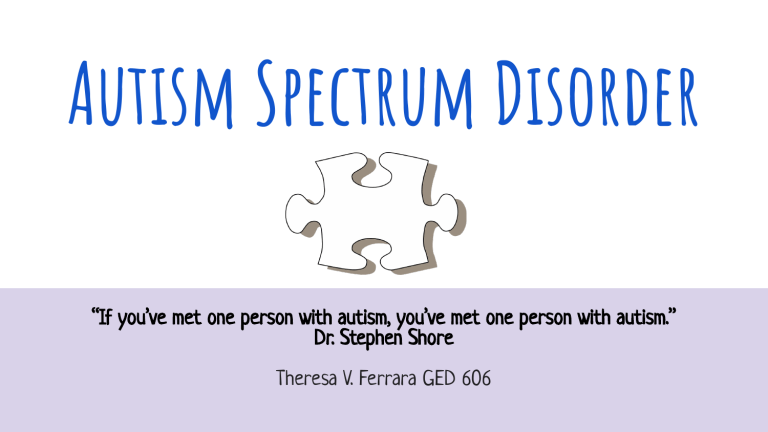
Autism Spectrum Disorder “If you’ve met one person with autism, you’ve met one person with autism.” Dr. Stephen Shore Theresa V. Ferrara GED 606 NJAC Chapter 14: Special Education 6A14-3.5 6A14-3.5 “Autistic” means a pervasive developmental disability which significantly impacts verbal and nonverbal communication and social interaction that adversely affects a student’s educational performance. An assessment by a certified speech-language specialist and an assessment by a physician trained in neurodevelopmental assessment are required. 6A14-4.2 Placement in the Least Restrictive Environment A1. To the maximum extent appropriate, a student with a disability is educated with children who are not disabled; 2. Special classes, separate schooling or other removal of a student with a disability from the student’s general education class occurs only when the nature or severity of the educational disability is such that education in the student’s general education class with the use of appropriate supplementary aids and services cannot be achieved satisfactorily; 3. A full continuum of alternative placements according to N.J.A.C. 6A:14-4.3 is available to meet the needs of students with disabilities for special education and related services; 9. A student with a disability is not removed from the age-appropriate general education classroom solely based on needed modifications to the general education curriculum; Autism Spectrum Disorder: Types Vary in severity and expression of symptoms This disability is usually identified by the age of three SOCIAL INTERACTION COMMUNICATION STEREOTYPES COGNITION Lack of eye contact Unawareness of social situations Little to no verbal communication Repetitive, echolalic, or robotic speech Inflexible routines Motor repetitions (finger flapping, body rocking May have intellectual disability May have savant characteristics Loss of social skills and environment (first few years) Severely impaired expressive and receptive language Develops hand movements between ages 5-10 months Often associated with severe or profound intellectual disability Childhood Disintegrative Disorder Level 3 (rare) Loss of interest in environment starting between 2-10 yrs. Lack of social reciprocity Loss of language skills around 2-10 yrs. Repetitive use of language Lack of make believe play Develops repetitive motor movements such as hand flapping Restricted activities and interests Usually associated with intellectual disability, The loss of skills is progressive Asperger Syndrome (Levels 1-3) Now called ASD Lacks ability to read social cues Awkward eye contact *Interested in soc.environment No clinically significant delay of language May be delayed Restricted areas of interest (e.g. preoccupation with a topic) Inflexible adherence to routines Repetitive motor movements No clinically significant delay in cognition Autism ASD Levels 1-3 Rett Syndrome, ASD Level 3 (rare) Journal Article: Reading Comprehension and Autism in the Primary General Education Classroom Neal Nghia Nguyen, Patrick Leytham, Peggy Schaefer Whitby, Jeffrey I. Gelfer, The Reading Teacher, Vol. 69, Issue 1 Cognitive Deficits of students with ASD affect their ability to comprehend text: Theory of Mind (ToM): the ability to interpret one’s own and other people’s mental and emotional states https://www.youtube.com/watch?v=YGSj2zY2OEM Weak central coherence: a limited ability to understand context or to “see the big picture” Executive functioning: the process of organizing, planning, and monitoring progress in situations *Around age 8, students with ASD begin to fall behind in assessments of comprehension. Strategies for Teaching Reading Comprehension ● ● ● ● ● ● ● Access and Build Background Knowledge - use visual supports, preteach key vocabulary Create Mental Images - do a picture walk, tapping into their visual strengths Make Connections - GRAPHIC ORGANIZERS - story elements: characters, setting, sequence, etc) Engage in Consistent Discussions - reciprocal questioning modeling ‘Why did the character do ___?” Stop frequently to ask what is happening and identify character actions and feelings. Make it multisensory - Act out actions and feelings of characters (or in SS/historical figures) Summarize Understanding - Use “think aloud” to create causal connections (What led __ to do __?) Linking Text to Self: Reading Informative Text on Birds I sleep in a bed. Same: We sleep on something Both things are soft. Birds sleep in a nest. More Strategies for Building Reading Comprehension ● Role play story events ● Summarize with drawings ● Use Cloze sentence and paragraph summaries ● Make predictions with cueing ● Story Characters - Emotional thermometers, What is the character thinking about ___? color coding feelings ● Teach “Shades of meanings” - related words ● Create speech or thought bubbles for characters or events ● Explicit teaching of figurative language What would the character say about ___? Social Emotional Learning: Direct Teaching The University of Pittsburgh, together with The Fred Rogers Company, created this DVD entitled “Friends and Feelings: Helping Children with Autism in Social and Emotional Learning.” 4 episodes, modeling social-emotional skills: ● Waiting ● Helping ● Asking for help ● Being flexible ● Managing frustration and anger ● Thinking about the feelings of others Classroom Structure Considerations ● ● ● ● ● ● ● Provide a predictable environment Seat in a position of least distraction and proximity to visual schedules Foster independence as much as possible Give concrete instructions Find ways to connect new learning to past experiences Chunk assignments, plan a completion schedule Directly teach procedures for completing a task (such as taking a multiple choice test or giving an opinion with reasons) Classroom Instructional Strategies ● ● ● ● ● ● ● ● ● ● ● Establish collaborative relationships with families Observe and develop a list of key social deficits and the social situations in which they occur Choose a few functional and age-appropriate target skills to address with a problem-solving intervention Involve paraprofessionals with education, clear communication, and tools Social Stories: https://www.pbisworld.com/tier-2/social-stories/ book: Skillstreaming the Elementary School Child by Ellen McGinnis and Arnold P. Goldstein Use picture and word schedules (ipad can be discreet) Establish and stick to predictable ROUTINES Look for environmental sensory sensitivities and try to reduce or eliminate them Don’t confuse lack of tact with rudeness Explicitly teach how to have productive conversations (scripting) Protect from teasing and bullying Conduct a Preference Assessment For both objects and activities: Effective reinforcers Increase likelihood of successful interventions Generalization of Behaviors ● ● ● ● ● Occurs if behavior occurs under different, untrained conditions Try out behavior in different settings Try with different aides, teachers, peers Try using different materials Make it as natural as possible More Activities for Social-Emotional Learning Sharing Time practice speaking and active listening Emotion Cards identify emotion and context Board Games teach sportsmanship etiquette What Would You Do? Scenarios SENSORY CENTER: Can strengthen self-regulations and help students cope with reactions to toucH, sound, scent, sight and movement The 2013 revision of the Diagnostic and Statistical Manual of Mental Disorders (DSM-5) lists hyper- or hypo-reactivity to sensory input or unusual interests in sensory aspects of the environment as one of four types of restricted, repetitive patterns constituting diagnostic criteria for ASD. Sensory Strategies are designed to address the student’s level of arousal, helping students reach a more optimal learning state. Determine the sensory needs of your student through trials (or an occupational therapist) and prepare a learning station based on the specific sensory needs of the student. Options for Sensory Centers *be cognizant of allergies* Movement /Vestibular Center: Swing, rocking chair, dance, yoga poses, exercises, tunnel crawl, trampoline Tactile Center - bumpy balls, squishy balls, tape, rocks WET activities Center - shaving cream, water, slime, bubbles, ice cubes Pouring Center - Sand, rice, beans, funnels, measuring cups, trucks, diggers, dump trucks Balloon Center - blowing, stretching, bouncing, popping Soft Center - pompoms, cotton balls, soft fabrics, carpet squares play dough Smell Center - coffee, smelly coloring markers, perfume Noise Center - squeaking toys, instruments, tubes for listening to your own voice, music, bells, chimes Assistive Technology Supports (AT) https://www.verywellhealth.com/assistive-technology-for-autism-5076159 Low Tech Weighted vests Sensory balls Picture boards PECS Color-coded planner Cuisenaire rods Theraputty Mid Tech ● ● ● ● ● ● Noise-cancelling headphones Battery-operated sensory toys Visual timers Calm app -visual and verbal meditations and breathing exercises to lower anxiety.. Model Me Kids: Social Skills videos that teach polite conversation skills and other verbal interaction skills. Proloquo2Go - Users touch images and the app “speaks” for them, customizable, and available in several languages. Features about 10,000 words. Costs about $250. High Tech Speech-to-Text software: Using the built-in microphone on an ipad, laptop, or cell phone, STT converts what the user says into text without the use of a keyboard. With increased use, the device errors are minimal. Resource: Parents of Autistic Children www.POAC.net POAC is a 501(c)3 nonprofit organization that provides events for the autism community, including training for parents and educators, recreational and support services to children with Autism Spectrum Disorder and their families, and training for police and first responders in New Jersey. Events include story time, gymnastics, pool parties, swim lessons, a barbeque bash and more. The Mantra of POAC is “Making Lives Better Every Day” 1989 NJ-88, Brick Township, NJ 08724 Phone: (732) 785-1099 Temple Grandin, PhD: University Professor and animal behavior scientist with autism. Researcher and advocate for those with autism. Templegrandin.com https://www.youtube.com/watch?v=MWePrOuSeSY Temple Grandin (1 hour)”The Autistic Mind” https://www.youtube.com/watch?v=IqntS1YRRO4 Temple Grandin: Educating Different Kinds of Minds (20 minutes, school focused) MOVIE: The Temple Grandin Story HIGHLY RECOMMEND!! This resource Guide Can be used by parents, teachers, CST members, advocates or administrators to assist with understanding and dealing with the needs of students diagnosed with ASD. Some ideas listed in this presentation may not be available in every school district or environment.



